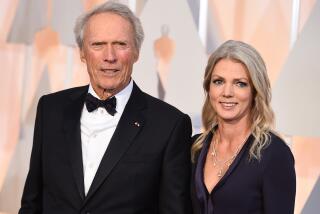VIDEO : ‘F for Fake’ Joins Orson Welles Rarities : The mischievous ‘70s documentary is new to home viewers, as is the uncut ‘Third Man’ and his turn in ‘Three Cases of Murder.’
The caped figure on the rail way platform holds a child spellbound as he performs a magic trick. A key disappears, reappears and is seemingly transformed into a rush of coins. “Up to your old tricks,” a beautiful bystander calls out. “Why not,” he replies in that instantly recognizable bass voice. “I’m a charlatan.”
Orson Welles is up to his old tricks in “F for Fake,” available for the first time Tuesday on Home Vision Cinema, an independent, Chicago-based fine arts label. Welles also figures prominently in a companion Home Vision release, “Three Cases of Murder,” a lesser-known 1954 British anthology film that features Welles as the title figure in “Lord Mountdrago,” a segment based on a Somerset Maugham story about a guilt-ridden politician driven mad by conscience. Both retail for $38.95.
Completing a trilogy of releases featuring Welles is the home video premiere of Carol Reed’s 1949 masterpiece “The Third Man,” in its original, uncut British version along with introductory narration by the director. It retails for $24.95.
“F for Fake” joins on video other recently rediscovered Welles rarities, including his uncompleted documentary “It’s All True” (Paramount Home Video), “Orson Welles’ Ghost Story” (the retitled Oscar-nominated short subject “Return to Glennascaul,” available on MPI Home Video) and “Othello” (currently on moratorium).
The video release of “F for Fake” makes accessible this mischievous film, which like much of Welles’ work has a spotty distribution history. It was completed in 1973 and premiered at the San Sebastian and New York film festivals. It was released in Europe before it received limited art-house play in the United States in 1977.
Welles escorts viewers “through the looking glass” into the world of true lies, trickery and fraud as practiced by art forger Elmyr de Hory and his biographer, Clifford Irving, who himself scammed the literary world by forging an autobiography of Howard Hughes. Welles speaks of his own “flight into fakery,” his “War of the Worlds” broadcast, and also presents some tantalizing “insights” into his monumental first film, “Citizen Kane.”
Much of “F for Fake”’ consists of footage originally shot in 1968 by Francois Reichenbach for a documentary about De Hory. After Irving’s hoax was exposed, Welles bought Reichenbach’s footage and re-edited it with new scenes he directed. It reportedly took a year working seven days a week to edit the film.
“It is a stylistic departure,” said critic Jonathan Rosenbaum, author of the just-published collection “Placing Movies: The Practice of Film Criticism” and the editor of “This Is Orson Welles,” by Welles and Peter Bogdanovich. “But everything he did was a stylistic departure. He never did the same thing twice. It has the quality of a personal essay. I think he exposes a lot of himself in terms of his feelings about his own work.”
It has been suggested that “F for Fake” was, in part, Welles’ answer to Pauline Kael’s controversial article in which she challenged his contributions to the “Citizen Kane” screenplay. Ironically, Rosenbaum noted, “F for Fake” is the only other film besides “Kane” in which Welles enjoyed complete creative control without any outside interference.
Also worth pondering, he said, is the dialectic between the titles: “It’s All True,” produced at the beginning of Welles’ career, and “F for Fake,” one of his last completed projects.
“Throughout his career, Welles had an ironic relationship with the documentary form,” Rosenbaum said. “Consider the ‘War of the Worlds’ broadcast and the fake newsreel in ‘Citizen Kane.’ ”
“F for Fake” is also notable, he said, as the only film for which Oja Kodar is known. As the co-writer of “The Other Side of the Wind” and other unfinished and unreleased projects, she was one of Welles’ closest collaborators in the last 25 years of his life. She is currently working on a compilation film comprising excerpts from these projects.
A s the sales success of such commercial hits as “Forrest Gump,” “Speed” and “The Mask” indicates, there is a growing video consumer market outside the traditional family base. Studios are aggressively excavating untapped treasures in their vaults. Recent examples include FoxVideo’s “Studio Classics” collection and MCA/Universal’s “Cecil B. DeMille” and “Claudette Colbert” collections.
In association with Janus Films, Home Vision has staked out its claim in this niche market by compiling a catalogue of foreign film classics and notable art-house releases and releasing them in restored and enhanced editions. The Italian-language, English-subtitled version of Bruno Bozzetto’s “Fantasia” parody “Allegro Non Troppo,” a letterboxed version of Luis Bun~uel’s “That Obscure Object of Desire” and the first-ever release of the subtitled version of Federico Fellini’s Oscar-winning “Amarcord” (available next month) are not for film buffs only.
* “F for Fake” is available in video stores or by calling (800) 826-3456.
More to Read
Only good movies
Get the Indie Focus newsletter, Mark Olsen's weekly guide to the world of cinema.
You may occasionally receive promotional content from the Los Angeles Times.






